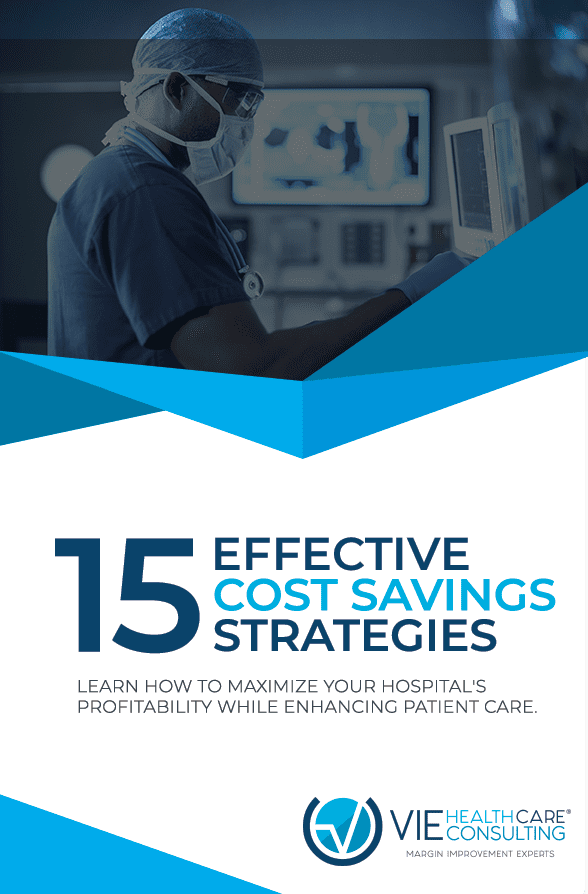Long Term Sustainability of Any Healthcare Organization
This article was written by Lisa Miller.
Establishing an agile cost transformation structure is essential for long term sustainability of any healthcare organization.
As CEO and founder of VIE Healthcare® Consulting, I have identified seven key components to achieve this.
Component One: Appoint a Dedicated VP of Cost
Like growth and other strategic priorities, cost-improvement should be a pillar of leadership, with a single leader guiding the charge.
Call it a “Cost Czar,” a “VP of Cost,” or a “VP of Cost Transformation,” a leader must first be appointed. That leader should report directly to the CEO and work with the supply chain Chief Medical Officer, Chief Nursing Officer, COO or CFO to pull all the components together for successful execution of your plan.
This VP of Cost must be fluent in working throughout the organization. They will need to know about the journey of a cost, which includes the following steps:
- Buying a product or service.
- Going into the item master to the charger master.
- How that gets mapped to reimbursement.
- How different people within the organization are using it.
Component Two: Culture
Cost-transformation must lie at the heart of your organization’s DNA. From top to bottom, every employee needs to understand that cost-transformation affects them and that every person examining cost has the ability to impact patient care.
As a leader, you should use transparent and meaningful verbal or written communication to let employees know how you’re analyzing cost on a day-to-day basis – and not just in the big areas like outsourcing dietary or EVs – but across the board.
Component Three: Centralize Cost Improvement Projects on a Project Management System
All cost initiatives should be centralized and maintained on a single platform, accessible by the VP of Cost, the CEO or the C-Suite in order to track progress.
This platform should track and monitor the status of all cost-reduction or improvement initiatives, such as outsourcing, GPOs, and individual department initiatives. It is integral to a successful short-term and long-term plan.
Component Four: Invest In Resources
For a cost-improvement plan to be successful, your organization must be ready to make an investment not just in your employees who reside in the supply chain or purchasing areas, but also in those who have an impact on purchasing and who work with your vendors and suppliers.
At VIE Healthcare®, we have identified five areas where investment in resources is critical:
4.1 Project Management.
Every hospital should have either a robust internally or externally built (although I recommend externally built) project management system that can be customized to suit your own needs.
A project management system allows you to:
- Monitor and track every phase of the plan.
- Maximize potential cost savings and extract as much information as possible from it.
- Revisit past actions before moving on to future plans.
Regardless of which system you select, it should be used solely for executing the cost-saving and cost-improvement plan. Access to what’s previously been implemented and achieved gives you a knowledge base to inform future decisions related to turnover, for example, or if a vendor contract is up for review.
At VIE Healthcare®, we use a tool called Work Front to manage all of our clients’ projects, enabling us to understand the status of every project, identify potential problems and also highlight outstanding milestones to be completed.
4.2 Data Analytics.
In the section about implementation strategy below, I’ll discuss why data analytics is so important to getting buy-in from your stakeholders. But first, let’s talk about the investment you’ll need to make to get accurate and trustworthy data.
This could mean hiring one too many data analysts and a data scientist on site or outsourcing your data analytics altogether.
In some cases, I believe that outsourcing your data analytics is useful because you walk away with an independent, impartial, third-party view from a team with a tremendous amount of expertise.
Typically, an outsourced firm will not only slice and dice the data but send it back to you with an analysis of where there are issues and opportunities for improvement by looking at pricing, trends, and variations – to name a few.
4.3 Decision-making Criteria.
Decision making isn’t an art. It’s a science – and it’s critical to your planning.
Decision-making isn’t an art. It’s a science – and it’s critical to your planning. Click To Tweet
The way in which you make decisions around analytics, products and strategy is important to establishing decision-making criteria.
You’ll need to determine what investment you’re ready to make and who should be a part of that planning. Ultimately this will determine how your hospital allocates its budget, what items you’ll purchase and how much you’ll pay for that framework.
4.4 Negotiation.
With supply chain vendors growing increasingly skilled in their pricing tactics, some degree of negotiation training is critical for employees in the following categories:
- All those involved in a buying or purchasing role in your hospital or health system.
- Anyone who has some influence or works with vendors, even in a supporting role.
- Anyone who works with the products and services, either outsourced or purchased.
More advanced negotiations can be reserved for those on the front lines of purchasing and final decision making.
Introductory training should be considered for people like those OR nurses or physicians who influence the decision-making.
Ultimately what it comes down to is this: Great negotiators are essential.
4.5 Outside Use of Resources and Technology.

To create a long-term sustainable plan, you must be aware of all outside resources your hospital is using, and their function.
For example, this will include the outsourced resources you’re using in areas such as benchmarking, pricing tools, comparative data and even consultants who assist with initiatives or support the back-end.
You will ultimately determine to what degree and for how long these resources and investments are needed. The key to remember is that wise decisions are achievable when there’s no duplication of technology and that you have the support of all those resources.
As hospitals are expected to do more and more with less and less, this step is critical.
Component Five: Implementation Methodology
An implementation methodology is integral to creating a long-term sustainable strategy.
In other words, how is the core strategy going to be implemented?
To do this, you’ll need to identify the category, the opportunity gap or the need identified. Let’s look at a few examples:
Orthopedic implant pricing: Let’s use the specific example of your hospital examining the variation in laboratory testing. One opportunity may be in orthopedic implant pricing.
In many cases, hospitals use multiple vendors to provide the products and technology necessary to execute various procedures, all with different pricing structures for what they offer. In these cases, there may be opportunities to standardize all pricing to each specific component level.
Environmental services: Your system may be purchasing janitorial supplies and services from seven different companies when in reality you only need one or two suppliers. By analyzing everything related to environmental services, your processes can be standardized to improve overall cost savings.
Increasing costs: Without even identifying a specific need, you may notice that your budget lines in supply costs or your operating room are increasing. While you may not be able to immediately understand that this is happening, you can begin to investigate.
The next step in implementing a methodology process is related to project leads.
Each separate cost improvement or cost savings opportunity requires a project lead in addition to project sponsors to lead the charge and see it through to completion.
You’ll also need to have a solid definition of the exact data needed to achieve this.
Taking the example of the orthopedic analysis above, you would need to examine:
- Contracts.
- Spend data from your new material management system.
- Invoice data for a few months to identify where any additional costs are being added.
Next, you’ll need to analyze the bill-onlys to see how these constructs are put together.
Helpful questions include, “Is there a reason that you’re seeing a bill-only instead of the line-item detail in the material management system?”
All this information is critical to define the data needed for every specific cost-saving opportunity.
When you have gathered all the information you need, it’s time to analyze the data – but be aware that this is not a linear data analysis. You will need to examine various components.
Furthermore, in some cases, you may need to add reimbursement data. This may be required in anything that matches or lines up to a clinical service, like in the example of orthopedic analysis above.
The essential step to achieving your implementation methodology is securing stakeholder buy-in.
The essential step to achieving your implementation methodology is securing stakeholder buy-in. Click To Tweet
The presentation should be made to your CFO, COO, CEO, physicians or department directors in a brief, concise way to ensure success.
Your stakeholders must be confident that you are providing accurate information, the analysis was well-performed, and that the data can be trusted.
You would be surprised at how many cost improvement and cost savings plans are cut short due to a poorly executed presentation with questionable data.
Creating a collaborative implementation strategy can help to achieve full buy-in.

In my experience, the people who will be most impacted by your plan may be uncomfortable with multiple changes happening at the same time. One way to overcome their objections is to present your idea in full, but break the changes down into manageable segments over the course of a year.
Let’s say your team has identified a million dollar cost savings opportunity which will require a significant shift in your organization’s cultural mindset and the way in which things are done. My advice is:
- Look for the lower hanging fruit, the easiest things to implement first.
- Propose that a portion of the plan to achieve half the savings be implemented this year, with the remainder of the $500,000 savings or improvements to be implemented next year.
- Then present a plan for the actual strategy. Identify who will do what, who is responsible for different aspects of the plan, who will communicate it and who will support it.
- Finally, be sure to set milestones, or deadlines for achieving each phase of the implementation.
Now it’s time to start implementing your strategy.
Keep in mind that maintaining regular communication is vital to maintaining momentum. This is possible by:
- Regularly evaluating, documenting and communicating improvements in the areas of finance and performance.
- Reflecting on the lessons learned, ie, what worked or didn’t work in the process.
By doing this, stakeholders will not only continue to buy-in to your plan, but the new culture of savings becomes status quo in the mindset of everyone down the pipeline.
This is one of the reasons I love a project management system. You can include all that knowledge for future strategy.
The job isn’t done at this point, however. Three months after the plan is finalized, you must verify the work. Ask yourself:
- What are the outcomes and results?
- Are the results in line with projections or are there any notable differences?
- Did any unexpected issues or opportunities arise as the result of the strategies your hospital implemented?
- Are there parts of the plan that need to be changed, modified or improved?
If you do identify opportunities for changing or modifying the plan, just pivot.
Reframe your thinking and make changes to the plan accordingly.
Component Six: Accountability To Achieve Exceptional Results
Accountability to achieve not just any results, but exceptional results is vital to your health system. Hospital environments are constantly changing. As your cost-saving initiatives are being implemented, your hospital’s responsibilities in the areas of cost improvement, cost analysis and transformation are also evolving.
Being able to access all of your initiatives on a single project management dashboard allows you to provide reports, even at a weekly level.
It’s easy, though, for people to be lost in the data, so it’s also important to choose wisely when determining who needs the reports, what data needs to be presented and how often it’s delivered.
The CFO or COO is a good place to start when deciding who should receive weekly reports. But there may be others who need to be updated on the project status. Identify who those people are early on in the process.
To determine the what of reporting, you’ll need to establish different critical drivers during the process and which milestones are important.
Let’s look at the earlier example of the orthopedic analysis again.
If you’ve identified a million dollars in orthopedic cost savings over a period of four months but by month two you haven’t started vendor negotiations, that must be flagged as a potential problem. Remember, negotiations can take a month or more to complete once you’ve factored in all the back and forth in the process.
I’m a big proponent of self-management reporting. When initiatives are established, complete with timelines and goals, there’s an expectation that they will be achieved. If they’re not being achieved, the stakeholder needs to be able to explain why things aren’t working and what they’re going to do differently to reach the desired outcome.
This is more important than merely pushing a report out for an already-busy CFO to sift through and ask the right questions to try and resolve the problem.
By regular self-managing, there are few surprises when milestones become due and the project continues to move forward even when faced with hiccups along the way.
Component Seven: Measuring Your Achievements

The final component for developing an agile cost transformation structure for long-term sustainability is how your hospital will measure the result of its efforts.
This process begins with looking at real numbers based on actual utilization. I’m talking about taking time in the 13th month after the launch to review the previous 12 months.
Sometimes you’ll find that you missed the mark. Perhaps the analysis was wrong, or product utilization was different than anticipated. You may also find that the saving was even greater because of higher utilization.
But by going back and looking at the real outcomes, you can identify the true impact of the plan.
Another idea for measurement is to set up a template during the project management process, allowing you to take a monthly or quarterly look at things like pricing, specific products or category spend.
Category spend is actually a nice way to begin. Take, for example, your AP spend. You can categorize the data, but you also need a way to analyze the specific line item details.
The specifics – not the summary data, not the category data – will drive all the initiatives.
Some hospitals want to look at the results monthly, but I’ve found that given fluctuations in supplies, technology and physicians, the quarterly view gives a much clearer picture of how the initiatives are performing. Furthermore, it allows you to examine a fair comparison of how the quarter performed year over year and determine whether or not it’s time to revisit the initiative.
It’s great when stakeholders are measuring supply change because it means they’re engaged in the initiative, but it’s even more important for finance or some sort of independent analyst – typically someone who was not responsible for implementing the initiative – to take a lead role in measurement.
Ultimately, their role should be to provide unbiased proof that the initiatives were performed and that the numbers that were put forth as savings are actually being validated.
The outside view is important because it provides an opportunity to find even more potential areas for cost savings or may even highlight something that was previously overlooked.
In the end though, no matter what those results look like, your results need to be tied back into the overall mission of the organization.
Every single dollar saved goes back to the community and goes back into healthcare.
Ready to enhance and optimize your operating margin?
For a complimentary consultation, call our office today at 1-888-484-3332 or email Lisa Miller at lmiller@spendmend.com.



